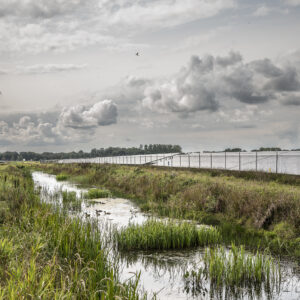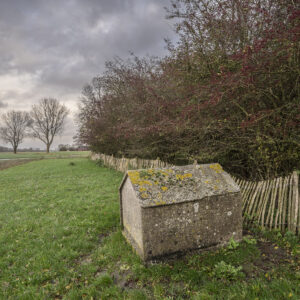Voyage of discovery through the region
Four years ago, Elles Bulder was one of the initiators of the Day of the Region in East Groningen. She says: ‘In fact we just started on a wing and a prayer. We got the idea from just across the border. The ‘Tag der Regionen’ was held in the Oldenburg region in Germany. We thought it was a great idea. We said to one another: We should do something similar in our own country, like a voyage of discovery through the region. We take too little pride in our own region. It would be great for the locals to visit places they would not normally think of. Also good for visitors getting familiar with the region.’
The first Day of the Region in 2004 saw 92 participating businesses and organisations. By now, the number has mushroomed to 145 participants. The most recent Day of the Region on 7 October 2007 drew a crowd of approximately 12,000 visitors. People could take part in activities such as walking, canoeing and horse-riding, restaurants had specials on offer, artist opened their doors to the public, museums waived the admission fee, companies organised guided tours and in many places special concerts and performances were held. And again, visitors were full of praise. On the same day, a certain Klara wrote in the visitors’ book on the web site: ‘An annual event that should be here to stay! So many things to do, such a diversity, enjoying all the attractions the Groningen countryside has to offer. Absolutely superb, and fine weather to top it all off. What else could one wish for.’
According to Elles Bulder, Day of the Region project leader right from the start, the formula for success is primarily in the low threshold of the project: ‘Our message is very simple, and as an organisation we are easily approachable. The great advantage of the formula is the fact that we can leave most of the organisation in the hands of the participants. We facilitate one or two things and we are in charge of publicity, but for the rest people look after themselves. From the start it had a kind of snowball effect that came out of nowhere.’
Leader Oldambt-Westerwolde has been involved almost from the very beginning of the Day of the Region, says Elles Bulder: ‘We also used the Day of the Region to make Leader projects better known to a wide audience.’
Collaboration of European regions
On a sheet of paper, Jan Beekman draws a complicated diagram of projects in all kinds of countries of the European Union, with lines connecting one to the other and many participations. Various European regions have been working together for many years They mutually inspire one another and take part in each other’s activities. Such development over many years created some sort of genealogy of successive European projects.
At the trunk of his ‘family tree’ Beekman draws the Pays Cathare project in the French Aude region: ‘I visited the Aude region many times. It is a most inspiring region if you are planning to market your own region at home. In the early 1990’s people in the southwest of France came to the conclusion that their agricultural production had dropped to the lowest in France. They decided to tackle the problem by fully concentrating on the quality of their products. Their Pays Cathare became a hallmark that people associate with quality and authenticity all over France today.’
European Village
One of the initiatives in the Aude was the large regional trade fair called Promaude, presenting all the products from Pays Cathare. Beekman: ‘In the course of time we had created closer ties with the French and with a number of regions in Belgium, Germany and Spain, allowing us to present ourselves as a ‘European Village’ at the 2005 Promaude fair.’
In the meantime we have seen the start of the 2006 PromEUregion collaboration project, in which ten regions from six EU countries are working together in the field of regional products and regional marketing. The input of Leader Oldambt-Westerwolde is the concept of the Day of the Region. Project leader Elles Bulder tells about it: ‘In PromEUregion we agreed that parties will allow one another to take part in their home events. Many colleagues made their presence felt at the latest Day of the Region. As in previous years, we have received much positive feedback.’
The last Leader project saw the gradual formation of a European network of regions exchanging information and learning from one another’s experiences. ‘You take something from here, you bring something from there’, says Jan Beekman as he is looking at his diagram.
Collaboration with Hungary
Péter Borjan is mayor of the Hungarian town of Koszárhegy in the Sárvic region of the Hungarian province of Fejér. More or less by coincidence, Borjan and his colleagues in the region came in contact with Leader Oldambt-Westerwolde. The result was the Sárwold project. Borjan tells about his contacts with East Groningen: ‘Groningen people have helped us in getting the project off the ground. We were able to utilise their experience in the development of rural regions to draw up our own planning for development. Our collaboration has had a favourable effect in many ways. Not only did we manage to land a Leader project as a result, but Sárwold has effectively become a bridge between our southern part of the Sárvic region and the northern Székesfehérvár region.’
Jan Beekman says his contact with the Hungarians was no one-way communication for sure: ‘We learned quite a few things ourselves. For instance, how to get a process of regional development started if there are hardly any organisations taking the initiative and life is a constant struggle for manpower and resources.’
According to Beekman, only a visit to Groningen could convince the Hungarians and make them see the achievements through collaboration: ‘I learned the importance of such exchanges in that people can see things happening with their own eyes. Then they know what it is really all about.’
Dutch model is inspiring
Peter Szolga is Jan Beekman’s Hungarian colleague. What would be the most important development to date according to Szolga? ‘To me, the most important issue is the growing collaboration between local authorities and the business community in the region. Thanks to Leader, the lower rated regions will be in a better financial position to take advantage of recent developments.’
Peter Szolga hopes to continue his collaboration with Groningen to further strengthen his programme. Mayor Péter Borjan also expects much from the ‘Dutch model’ for the development of rural areas: ‘The Dutch initiatives are setting an example and are inspiring. Their experience is a role model for us, but the Dutch partners also benefit from the Hungarian experience and knowledge.’
New connections and networks
Elles Bulder needs no time to think when asked why she believes the Day of the Region has been so successful in East Groningen: ‘It has been a project in the hands of the region right from the start. You have no idea how much people appreciate being able to phone someone in Scheemda rather than in the city of Groningen for more information. That is because we have become used to it.’
The approach of starting at grassroots level is most stimulating. Autonomous developments in the region are coming together in new connections and networks. The Day of the Region is a fine example of that.


